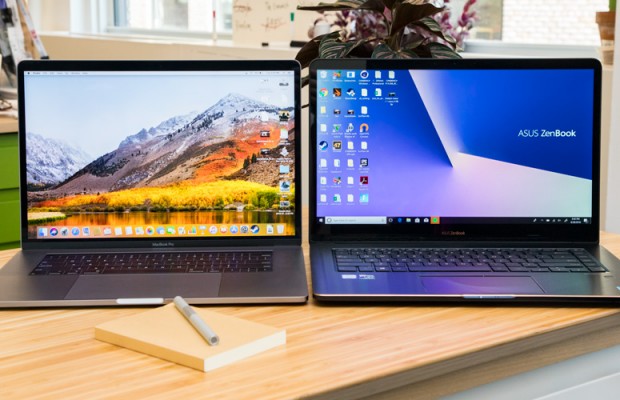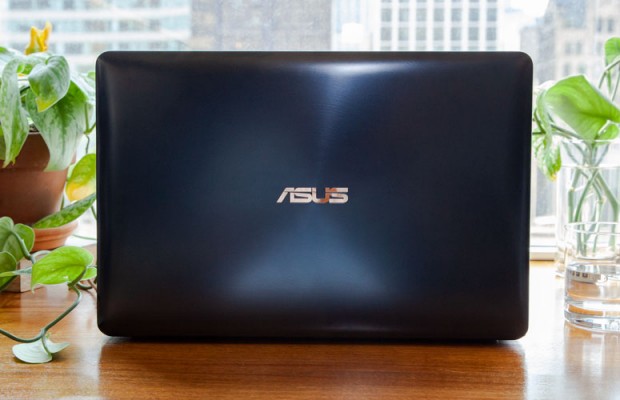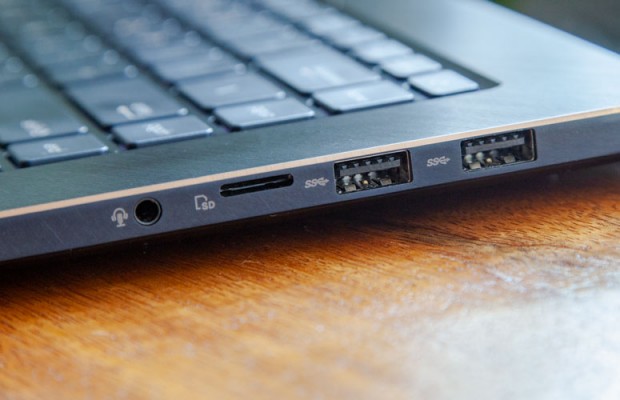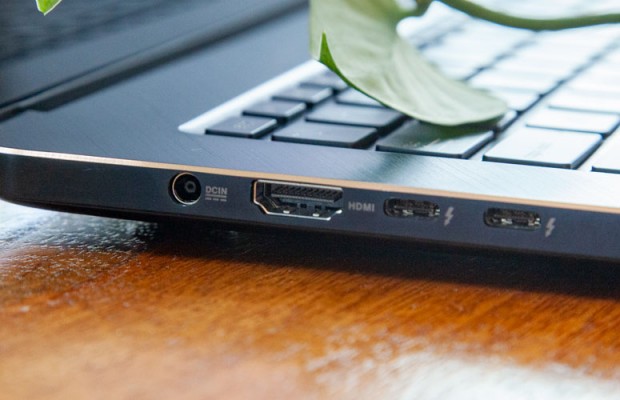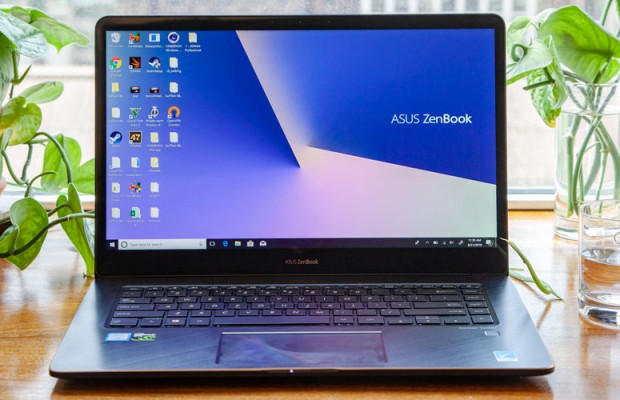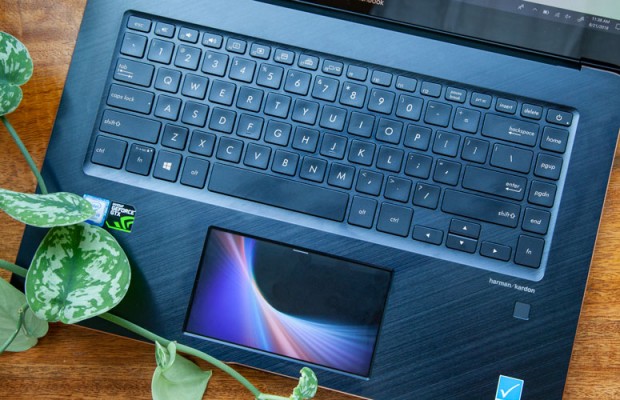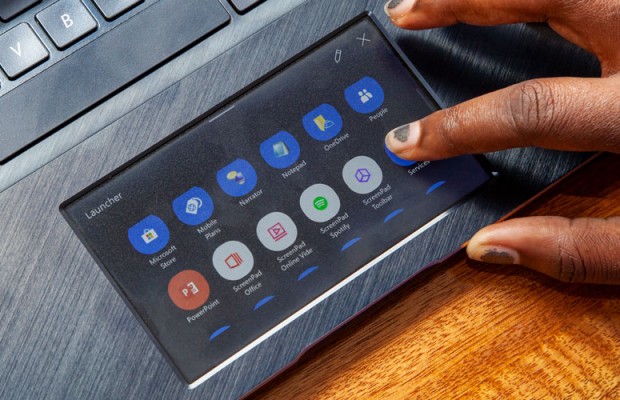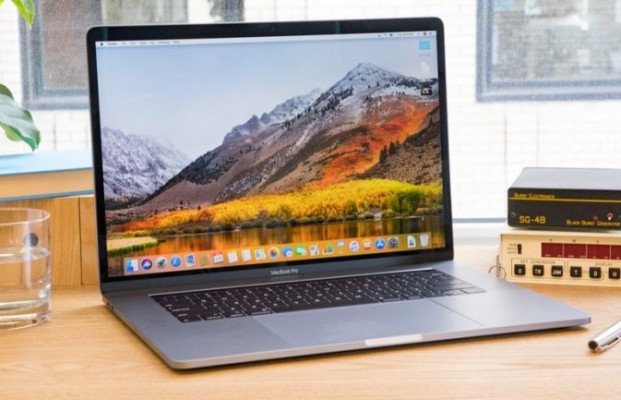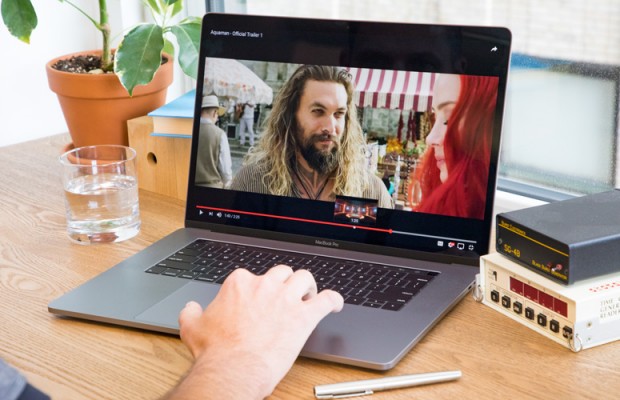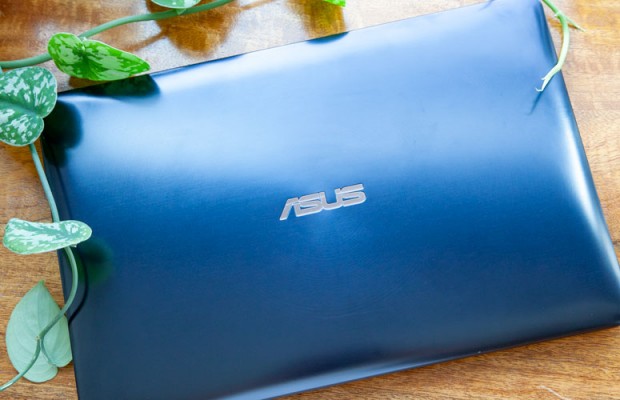Apple MacBook Pro (15-inch) vs. Asus ZenBook Pro 15: Face-Off!
The Apple MacBook Pro and Asus ZenBook Pro 15, two of our favorite 15-inch laptops, were recently refreshed with the latest internals and some compelling new features. The MacBook Pro is a conservative upgrade from last year's version, whereas the ZenBook Pro 15 introduces a striking new design and an innovative touchpad that doubles as a secondary display.
These two laptops have a lot going for them, including high-resolution displays and available Core i9 processors. They also come equipped with dedicated graphics cards for casual gaming.
The MacBook Pro and ZenBook Pro 15 scored high marks in our reviews, and are among the best premium laptops on the market, but which is right for you? Let's find out.
Apple MacBook Pro vs Asus ZenBook Pro 15: Specs Compared
| Row 0 - Cell 0 | Apple MacBook Pro (15-inch) | Asus ZenBook Pro 15 |
| Price (Starting/as configured) | $2,399 ($4,699) | $1,799 ($2,299) |
| Colors | Silver, Space Gray | Deep Dive Blue and Rose Gold |
| Display | 15.4-inch 2880x1800-pixel | 15.6-inch 4K, 15.6-inch 1080p |
| CPU | 8th Gen Core i7, i9 | 8th Gen Core i5, i7, i9 |
| RAM | 16GB, 32GB | 8GB, 16GB |
| SSD | 256GB, 512GB, 1TB, 2TB, 4TB | 256GB, 512GB, 1TB |
| Key Travel | 0.7 mm | 1.1 mm |
| Ports | 4 Thunderbolt 3, headphone | 2 USB 3.1 Type-A, 2 Thunderbolt 3, HDMI, microSD card, headphone |
| Webcam | HD (720p) | VGA (480p) |
| Size | 13.8 x 9.5 x 0.6 inches | 14.4 x 9.9 x 0.7 inches |
| Geekbench 4.1 | 23,138 | 21,691 |
| Battery Life (hrs:mins) | 10:21 | 5:14 (touchpad off) / 4:05 (touchpad on) |
| Weight | 4 pounds | 4.2 pounds |
Design
If you've owned a MacBook Pro in the past few years, then the design of the new model needs no introduction. Apple kept the MacBook Pro's sleek, industrial aluminum chassis, which comes in Space Gray or Silver, and sports the iconic bitten-apple logo on the lid.
A massive touchpad takes up nearly half the deck, and the Touch Bar returns to replace the shortcut keys. There's nothing wrong with the MacBook Pro's design — it's sleek, stylish and thin, but after years without change, the laptop's look is starting to grow stale.
Sign up to receive The Snapshot, a free special dispatch from Laptop Mag, in your inbox.
That's especially true when you compare it with the Asus ZenBook Pro 15. The Asus, with its fashionable Deep Dive Blue chassis and golden trim, looks like it was designed for wealthy celebrities. The lid is embossed with a gold Asus logo, and there are faint concentric circles etched into the dark-blue aluminum.
Gold trim and diagonal striations on the deck tie together the laptop's chic design. But those stylish elements will likely go unnoticed, thanks to the ZenBook Pro 15's attention-grabbing ScreenPad, a touchpad that doubles as a secondary display (more details below).
MORE: Best and Worst Laptop Brands
The MacBook Pro and ZenBook Pro are surprisingly portable for 15-inch laptops, but the Apple machine is more compact. At 13.8 x 9.5 x 0.6 inches, the MacBook Pro is considerably smaller than the ZenBook Pro 15 (14.4 x 9.9 x 0.7 inches). It's also lighter, weighing 4 pounds, compared with the 4.2-pound ZenBook Pro 15.
Winner: Asus
Ports
The latest 15-inch MacBook Pro has four Thunderbolt 3 ports and a headphone jack. That's all.
So, if you want to connect legacy peripheral or transfer files from an SD card, then it's time to embrace the dongle life.
The Asus ZenBook Pro 15 has a better selection of ports, even if there are fewer USB Type-C inputs. The laptop has two USB 3.1 Type-A ports, a microSD card slot, a full HDMI, two Thunderbolt 3 ports and a headphone/mic combo port.
Winner: Asus ZenBook Pro 15
Display
Apple is known for its gorgeous Retina displays, and the new MacBook Pro upholds that reputation. The 15.4-inch, 2880 x 1800 panel has all the qualities we look for in a display: It's bright, colorful and sharp.
The 2018 MacBook Pro is also the first laptop to feature Apple's TrueTone technology, which adjusts the color and intensity of your display to match the ambient lighting of your environment. The feature is designed to make the display look more natural and reduce eyestrain.
The MacBook Pro's display is stunning, but don't write off the competition. The Apple laptop lost this round to the Dell XPS 15, and the Asus ZenBook Pro 15 is no slouch, either. The ZenBook Pro 15's 3840 x 2160-pixel display provides a more detailed image than the MacBook Pro, and its colors seem to burst off the screen. The 15.6-inch panel is also touch-sensitive, so you can take notes or draw with a stylus.
In our testing, the MacBook Pro reproduced 117 percent of the sRGB color gamut. That's a respectable result, but the ZenBook Pro 15 was even more colorful, achieving an outstanding 141 percent. The premium laptop average is 112 percent.
MORE: Laptops with the Most Colorful Screens
The MacBook Pro's display is bright, reaching a maximum of 354 nits. The ZenBook Pro 15 falls just short at 330 nits. Both displays are brighter than the category average (309 nits), so you shouldn't have problems using them in bright conditions.
Winner: Asus ZenBook Pro 15.
Keyboard and ScreenPad/Touch Bar
If you're a typist who, like us, prefers deep key travel (at least 1.5 millimeters), then these premium laptops aren't for you. Their shallow keyboards aren't the most comfortable to use for long typing sessions.
The Asus ZenBook Pro 15 has a key travel of 1.1 millimeters, which is below the 1.3mm premium laptop average. The MacBook Pro's keys are even more shallow, with travel of just 0.7mm. Thankfully, the force required to register a keystroke on the ZenBook Pro 15 (65 grams) and the MacBook Pro (63 grams) ensures that you'll hit your peak typing speeds.
In real-world testing, my vote goes to the ZenBook Pro 15. The laptop's keys have a pleasant tactile bump and there's enough key travel to prevent you from bottoming out. I hit 117 words per minute in the 10fastfingers.com typing test with an accuracy rate of 95 percent. That's just below my 119 wpm average and equal to my 5 percent error rate.
While quieter than last year's model, the MacBook Pro's keys feel stiff. I could muster only 103 wpm in the 10fastfingers.com test, and my accuracy rate fell to 91 percent.
The ZenBook Pro's highlight feature is unquestionably the touchpad, which doubles as a secondary display. The 4.8 x 1.6-inch, 1920 x 1080 LCD touch screen called ScreenPad is Asus' answer to the Touch Bar. It has four modes: ScreenPad, Extension Display, Traditional Touchpad Mode or Touchpad Disabled.
The main mode features a toolbar with shortcut icons that open apps and programs. Some of our favorite shortcuts include Spotify, Calculator and Music Player. You can also use the screen extension setting to turn the touchpad into a true secondary display.
MORE: Which GPU is Right For You?
The MacBook Pro brings back Touch Bar, which replaces your keyboard shortcut keys with a narrow touch-sensitive OLED display. This year, it has a new T2 chip that enables security measures like an encrypted SSD and a secure boot process. In general, the ZenBook Pro 15's ScreenPad is more useful than the Touch Bar, though it requires some practice.
Winner: Asus ZenBook Pro 15.
Performance
Equipped with the same Intel Core i9 CPU, the Asus ZenBook Pro 15 and Apple MacBook Pro offer plenty of power to run even the most demanding processes. But while the ZenBook Pro 15 has excellent performance, it just couldn't keep up with the MacBook Pro in most of our tests.
Our ZenBook Pro 15 review unit was equipped with an Intel Core i9-8950HK CPU, 16GB of RAM and a 512GB SSD. The MacBook Pro we reviewed had the same Intel Core i9-8950HK, but was configured with 32GB of RAM and a 2TB SSD.
In the Geekbench 4.1 overall performance test, the ZenBook Pro 15 scored 21,691, which is just short of the MacBook Pro's 23,138. The Asus ZenBook Pro 15 fought back in the Excel Macro Test by matching 65,000 names to their corresponding addresses in 40 seconds. It took the MacBook Pro 52 seconds to complete the same task.
The Apple MacBook Pro destroyed the Asus ZenBook Pro 15 (and every other laptop) in the Laptop File Transfer test, which determines hard-drive speed. The MacBook Pro's 2TB SSD blazed through the benchmark, duplicating 4.97GB of multimedia files at a rate of 2,600 megabytes per second. That makes the solid result achieved by the Asus ZenBook Pro 15's 512GB SSD (424.1 MBps) look downright sluggish.
The MacBook Pro also outpaced the ZenBook Pro 15 when converting a 4K video to 1080p using the HandBrake app. It completed the demanding task in 10 minutes and 16 seconds, which is faster than the ZenBook Pro 15 (10:52).
MORE: Laptops with the Best Productivity Performance
Neither of these laptops are gaming powerhouses, but the ZenBook Pro 15 is the better machine for getting the occasional Fortnite match in. While both laptops played our Rise of the Tomb Raider benchmark (1080p at max settings) at 21 frames per second, the MacBook outperformed the ZenBook Pro 15 in our Dirt 3 benchmark, reaching 83 fps, compared with the ZenBook's 74 fps.
So why should gamers buy the Asus? Simple because most games — Middle Earth: Shadow of War, Overwatch and FIFA 19, to name a few — are developed for Windows, not macOS.
Winner: Apple MacBook Pro.
Battery Life
Regarding battery life, there is one clear winner: the MacBook Pro. It endured for 10 hours and 20 minutes in the Laptop Mag Battery Test, which involves continuous web surfing over Wi-Fi at 150 nits of display brightness.
The ZenBook Pro 15 stayed powered for a measly 4 hours and 5 minutes with its HD touchpad screen turned on. It did only slightly better when we reran the test with the ScreenPad off, shutting down after 5 hours and 14 minutes.
Winner: Apple MacBook Pro.
Value
For $1,799, the base model of the Asus ZenBook Pro 15 has a traditional touchpad and is equipped with an Intel Core i7-8750H CPU, 16GB of RAM and a 512GB SSD. You also get Nvidia GeForce GTX 1050 Ti graphics with 4GB of memory. The $2,299 unit we reviewed adds the ScreenPad and boosts the CPU to an Intel Core i9-8950HK.
There are no two ways about it: the MacBook Pro is much more expensive. The 15-inch laptop starts at $2,399 for a configuration with an Intel Core i7 CPU, 16GB of RAM, a 256GB SSD and Radeon Pro 555X graphics. You can bump up the CPU to a Core i9 for an additional $400. Our review unit costs $4,699, which puts it firmly in workstation range. The decked-out config included a Core i9 CPU, 32GB of RAM, a 2TB SSD and a Radeon 560X GPU with 4GB of memory.
Winner: Asus ZenBook Pro 15.
Overall Winner: MacBook Pro
| Row 0 - Cell 0 | Apple MacBook Pro (15-inch) | Asus ZenBook Pro 15 |
| Design (10) | 8 | 9 |
| Ports (10) | 6 | 8 |
| Display (15) | 12 | 13 |
| Keyboard/Touchpad (10) | 6 | 8 |
| Performance (20) | 19 | 17 |
| Battery Life (20) | 18 | 11 |
| Value (10) | 5 | 7 |
| Overall (100) | 74 | 73 |
Both the 15-inch MacBook Pro and ZenBook Pro 15 are highly recommended, but Apple's laptop wins this contest by a narrow margin. The ZenBook Pro 15 took more rounds, but it's important to consider how decisively Apple dominated the categories it won, particularly battery life.
The MacBook Pro lasts about twice as long as the ZenBook Pro 15, even when the Asus' touchpad display is disabled. Add in faster performance, and the MacBook Pro 15 is a compelling option for power users.
The Asus ZenBook Pro 15 is a capable laptop in its own right. It has a gorgeous 4K display, and the innovative ScreenPad is genuinely useful, though it takes a toll on battery life. The ZenBook Pro 15 also has a striking design that is sure to turn heads. Oh, and it's a heck of a lot cheaper.
Credit: Laptop Mag
Phillip Tracy is the assistant managing editor at Laptop Mag where he reviews laptops, phones and other gadgets while covering the latest industry news. After graduating with a journalism degree from the University of Texas at Austin, Phillip became a tech reporter at the Daily Dot. There, he wrote reviews for a range of gadgets and covered everything from social media trends to cybersecurity. Prior to that, he wrote for RCR Wireless News covering 5G and IoT. When he's not tinkering with devices, you can find Phillip playing video games, reading, traveling or watching soccer.
